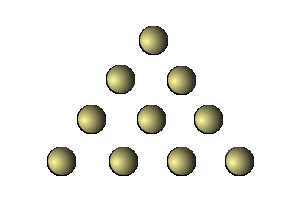




"What is absolute unity? This is the way in which the study of the one has a power of drawing and converting the mind to the contemplation of true being"
Plato, The Republic, Book VII
Strange to modern ears is the idea of qualitative number theory. This is the basic and ancient idea that number has meaning above and beyond quantity. It is this:
and so on, but that is enough for our purposes here.

My own studies have led me to the conclusion that, in terms of enneagram numbers, the number 1 is not noted (or, rather, it is the whole circle and at the same time a point in the center of it, the alpha and omega), 2 is enneagram point 5, 3 is point 7, 4 is point 1, 5 is 4, 6 is 2, and 7 is 8. This is the order of the inner circulation of the enneagram when beginning from the center and proceeding to point 5.
A beautiful (for economy of material—Henry Ford might agree) expression of this is the Pythagorean tetractys:

Visually, we see unity, a whole triangle. One, at the top of the triangle, radiating down, so to speak, into two, then three, and finally four. This is the image of creation: Unity (1) reflects (2) on itself and spawns relationship (3) which gives rise to material existence (4). It is the basic creation myth. (The total is ten, as in the 10 sephiroth of Kaballah, or the ten points of the enneagram (0-9), or our decimal number system, and so on in qualitative number theory in general.)

In terms of the sequence of dimensions, we can see this very plainly (refer to The Theory of Six Dimensions for a related discussion). Number 1, unity, is the zeroth dimension, the point. Everything else proceeds from this. By duplication, the point becomes the line. This is 2, because 2 points describe a line, and the first dimension. At right angles to itself (or just curving out from itself), the line becomes a plane. This is 3, as three points can define a plane. Curve or extend again into the next dimension of space, the third dimension, and you have 4, as four points are minimally required to describe a three dimensional object—material existence.
At this point, space dimensionality cannot be further extended. Try drawing a four-dimensional object with five points. The fourth dimension requires time, and the fifth point may be seen as a point in the past or the future of the 3-dimensional object. The number five, associated with growth and life, requires time.
The number six has to do with movement in space, and 6 points in our dimensionality discussion is repetition, movement over time.
Finally the number 7, or attainment, represents the six dimensions, all the possibilities for the phenomenon under discussion.
In ancient or modern theories of creation, we see the same development. Unity, 1, splits and becomes 2. Adam becomes Adam and Eve, or God is reflected on the waters, or the photon initiates pair-production, and so on. Three is relationship, the family of Adam, Eve, and Cain/Abel, or the indivisible Trinity, or the relation of fundamental particles in the atom. Material existence is the race of humanity, the world of molecules. Growth is life. And "Life is a movement and a rest." And that is everything, until we begin again, on a new scale, with a new intent.

The discussion of (and more importantly the contemplation of, or meditation on) number, begins with 1. Such contemplation is infinitely rich. Try it. See if one does not lead to two, and two to three. (And watch for that "I" that says: "What about 1 and one half?") Contemplation, as number, progresses this way because it, like the second stair, must be after the first stair. Number does not, and cannot, proceed otherwise. The personal realization of this, founded in one's own meditations, say, in pursuing it over hours and months of insomnia, or days and years of contemplation, comes like a flash of lightning—all is number. Not like the counting we learned as children: 1, 2, 3...; but as sacred meaning: 1, 2, 3...
It is God (1), Mother (2), and Child (3), however it is put in religious and mystical teaching. All comes from one, and returns to one.
"[H]appiness consists in knowledge of the perfection of the numbers of the soul."
Pythagoras, from Clement of Alexandria

All pages © Copyright John Raithel